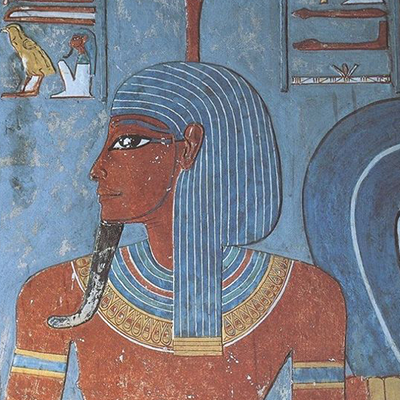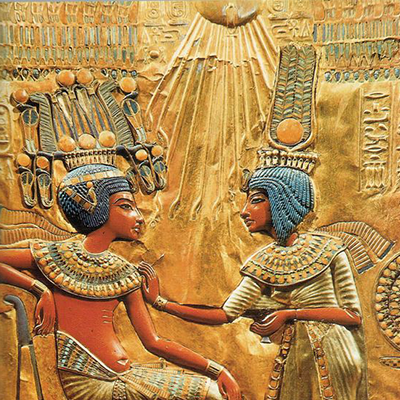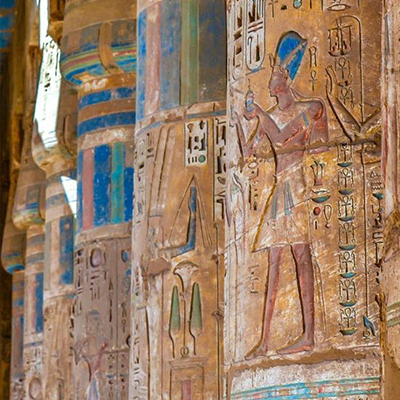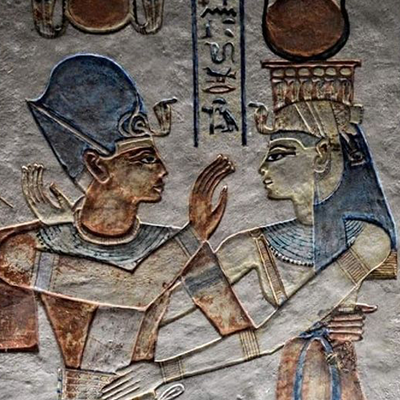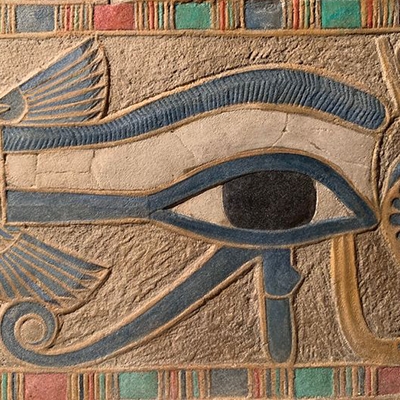1. Egyptian blue, Chinese blue,
and related 2D silicates
Egyptian Blue (EB) is an artificial blue pigment of mineral origin used also to mold small objects thanks to its vitreous ceramic nature (Lucas and Harris 1962; Chase 1971;
Delamare 1997). It was developed in Egypt during the Early Bronze Age, more than 5000 years ago (Corcoran 2016), and is considered to be the frst true synthetic pigment ever produced by humans (Riederer 1997; Warner 2011; Corcoran 2016; Greco 2022). EB largely owes its color and its extraordinary features to the crystals of CaCuSi4O10 (also CaO·CuO·4SiO2 or calcium copper tetrasilicate) that form during its manufacturing. This compound is the artifcial analogous of a mineral very rare in nature, i.e., cuprorivaite (Mazzi and Pabst 1962). Natural cuprorivaite (see Fig. 1) forms likely under hydrothermal conditions, i.e., high temperature and high-pressure conditions that occur beneath the Earth’s surface in the presence of water (Giester and Rieck 1994; Warner 2011; JohnsonMcDaniel et al. 2015; Cairncross and Rumsey 2022). It was identifed as a new mineral by Minguzzi in 1938 on a rock specimen from Mount Vesuvius (Minguzzi 1938). Some 20 years later, it has been correlated to the chemical composition of EB (Schippa and Torraca 1957; Pabst 1959; Mazzi and Pabst 1962), and since then, the terms «cuprorivaite» and «Egyptian blue» have been often used as synonymous (Mazzi and Pabst 1962; Gaines et al. 1997).
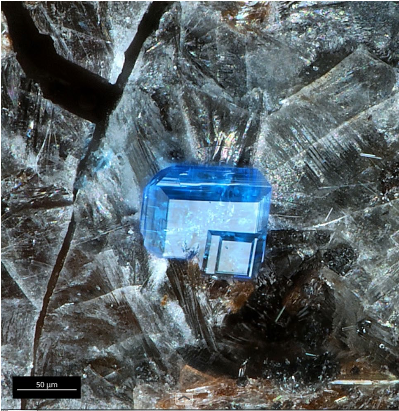
Fig.1 Natural cuprorivaite from Nickenicher Weinberg, Nickenich, Andernach, Eifel, Rhineland-Palatinate, Germany. Metric reference: 50 μm. Reproduced with permission from mindat.org © Christof Schäfer (finder of the mineral). Photo by Marko Burkhardt
However, artifcially produced EB, unlike natural cuprorivaite, is a multicomponent material (Ullrich 1979; Tite et al. 1984; Hatton et al. 2008) and generally contains a certain amount of amorphous silicate glass (Pradell et al. 2006) as well as some minor amounts of other crystalline phases relative to silica (quartz, cristobalite, or tridymite), silicates (e.g., wollastonite), and oxides (e.g., tenorite) (Jaksch et al. 1983; Etcheverry et al. 2001; Pradell et al. 2006; Aliatis et al. 2010). Due to its rarity, natural cuprorivaite has never been considered a blue pigment or a raw material (Riederer 1997; Berke and Wiedemann 2000). However, artifcial EB was widely used in antiquity,
although in those times and places other natural mineral alternatives were known and occasionally have been reported, e.g., azurite, lapis lazuli, and glaucophane (Kakoulli 2009). Countless archaeological fnds show that for over 3000 year EB was nearly the only blue pigment used in North Africa, Western Asia, and Europe until it was almost abandoned during the Early Middle Ages (see Sect. 4) (Scott 2016; Nicola et al. 2019; Švarcová et al. 2021; Sgamellotti and Anselmi 2022). There are some other materials closely related to EB that often show similar intriguing features. Two of them, analogously to EB, have been used in antiquity as pigments and have been named «Chinese Purple» (CP) and «Chinese Blue» (CB), since they were developed in ancient China (Berke et al. 2009). The main constituents of CP and CB are two layered barium and copper silicates, BaCuSi2O6 and BaCuSi4O10, respectively. The main constituent of CB has a structure analogous to that of CaCuSi4O10 in EB, the only diference being the presence of Ba2+ instead of Ca2+. The main constituent of CP is strictly related to BaCuSi4O10 in CB but has a diferent framework within a layer (Wiedemann and Berke 2001) (see Sect. 3.2). Although CP and CB have a composition and production technology quite similar to that of EB, they were developed in China more than two thousand years later, most likely independently of EB (Berke 2007; Qin et al. 2016). Quite recently the two extremely rare natural analogs of the main constituents of CB and CP have been also identifed, both in the Wessels mine, Kalahari Manganese Field, South Africa (Giester and Rieck 1994; Rieck et al. 2015). They were named, respectively, efenbergerite and colinowensite and are sometimes reported in association with the mineral wesselsite (SrCuSi4O10) which is the structural analogous of cuprorivaite with Ca2+ replaced by Sr2+ (Giester and Rieck 1996). Cuprorivaite, efenbergerite, and wesselsite share a similar structure and the same formula MCuSi4O10 (M=Ca, Sr, and Ba) and belong to the wider gillespite-type group of minerals MQSi4O10 (Pabst 1959; Salguero et al. 2014; Chen et al. 2016), where Q is an appropriate divalent cation that is basically in square planar coordination (Burzo 2009). The gillespite mineral that gives its name to the whole group is BaFeSi4O10 and was described for the frst time by Schaller in 1922 as a new mineral present in a rock specimen from the glacial moraine near the head of Dry Delta, Alaska (Schaller 1922; Pabst 1943). It is analogous to efenbergerite with Cu2+ replaced by Fe2+. Some other compounds that show the structure of gillespite-group minerals are known. They are MCrSi4O10 with M=Ca, Sr and Ba (Belsky et al. 1984; Miletich et al. 1997), and probably also BaMgSi4O10 (Yuan et al. 2012; Zhong et al. 2020). However, it seems that so far, they have not yet been found as natural minerals. Some attempts to replace Fe2+ with Co2+, Ni2+, and Mn2+ to produce other compounds with gillespite structure have been reported (Hassanein 1969; Nicolini and Porta 1970; Masse et al. 1999; Lee et al. 2013; Szubka et al. 2022) as well as to produce isostructural members with Ge replacing Si (Hassanein 1969; Riederer 1997). Furthermore, the production of roughly monoatomic sheets of pure crystalline hydrated silica starting from leached gillespite has been pioneered by Schaller (1929) and by Pabst (1958), and in the near future, it may become more attractive due to the recent improvement in the synthesis of artifcial gillespite (Bloise 2018). This kind of intriguing 2D hydrated silica could be very promising for some new technologies, such as for the production of zeolites (Frondel 1979; Marler and Gies 2012) and in many other felds (Fang et al. 2015).
